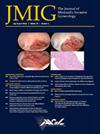Evidence-Based Practice for Minimization of Blood Loss During Laparoscopic Myomectomy: An AAGL Practice Guideline
IF 3.5
2区 医学
Q1 OBSTETRICS & GYNECOLOGY
引用次数: 0
Abstract
Study Objective
To provide evidence-based recommendations regarding the use of pre-operative medical adjuncts and intra-operative interventions for reducing blood loss during laparoscopic (conventional or robotic-assisted) myomectomy.
Design
A systematic review and meta-analyses of the relevant literature were performed to develop evidence-based guideline recommendations.
Setting
Published literature.
Patients
Patients undergoing laparoscopic myomectomy.
Interventions
Pre-operative medical adjuncts and intra-operative interventions for reducing blood loss.
Measurements and Main Results
The primary outcome was surgical blood loss. Secondary outcomes were change in hematocrit or hemoglobin and blood transfusion. Additional outcomes included length of procedure, intra- and post-operative complications, conversion to laparotomy, reoperation, readmission, and length of stay. A total of 75 studies fulfilled the eligibility criteria and formed the basis for this practice guideline. Evidence-based recommendations were developed regarding the use of pre-operative medical adjuncts including gonadotropin-releasing hormone agonist and progesterone), as well as intra-operative vasoconstrictors, uterine artery occlusion, electrosurgical devices and barbed suture.
Conclusions
Systematic review and multiple meta-analyses identified moderate evidence supporting the use of 3-month administration of leuprolide acetate prior to myomectomy and intra-operative use of misoprostol, epinephrine, vasopressin, oxytocin, and uterine artery occlusion for reducing blood loss during laparoscopic myomectomy.
求助全文
约1分钟内获得全文
求助全文
来源期刊
CiteScore
5.00
自引率
7.30%
发文量
272
审稿时长
37 days
期刊介绍:
The Journal of Minimally Invasive Gynecology, formerly titled The Journal of the American Association of Gynecologic Laparoscopists, is an international clinical forum for the exchange and dissemination of ideas, findings and techniques relevant to gynecologic endoscopy and other minimally invasive procedures. The Journal, which presents research, clinical opinions and case reports from the brightest minds in gynecologic surgery, is an authoritative source informing practicing physicians of the latest, cutting-edge developments occurring in this emerging field.

 求助内容:
求助内容: 应助结果提醒方式:
应助结果提醒方式:


